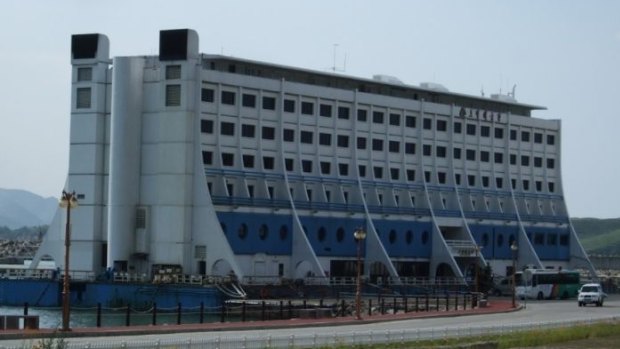This was published 5 years ago
Barrier Reef Floating Resort: The story of Queensland's bizarre floating hotel
By Julietta Jameson
Queensland's ambitious floating hotel was a curiosity throughout its short life on the Great Barrier Reef during the 1980s. And since the ABC aired a story on it recently, Robert de Jong, managing curator at the Maritime Museum of Townsville, has found out just how curious Australians are about it still. He's been inundated with information about and memories of what was the world's first of its kind, floating 70 kilometres off shore – the seven-storey, 200-room Barrier Reef Floating Resort, complete with tennis court, helipad and swimming pool.
Perhaps that's because the most curious fact about the edifice is its current whereabouts – North Korea – the location highlighted by the ABC right around the time that country's leader was meeting with the US President in Singapore.
How did it get there? Robert de Jong wants us to wind back a little, to how the floating hotel came to be in the first place.

Hotel Haegumgang, as it is now known in North Korea.Credit: Google Maps
The leisure facility is part of a wider exhibition he's putting together on Italian immigrant Doug Tarca, considered a pioneer of Townsville tourism.
"What actually led us to design an exhibition about this is we own the original model of the resort," says de Jong. "It was sitting in an attic. We brought it down, thinking maybe it would be a good permanent exhibit and then suddenly, it started getting bigger and bigger and has become a major project."
In the 1980s, de Jong says, "Townsville thought of itself as a working man's town, it was not very touristy at all."
Tarca had a permit to harvest coral, so along with his wife Marie, he created Doug Tarca's Coral Gardens, an onshore coral display. It seems sacrilegious today, but de Jong insists Tarca was a conservationist.
"He wanted to expose people to the beauty of the reef and was quite passionate about preserving it. In his early career, he was a diver. He thought, in order to protect the reef, people must be able to see it."
The coral gardens led Tarca to investing in a couple of fast catamarans that took people out to snorkel the reef, then to his Yellow Submarine, a glass-bottomed vessel that gave so many their first glimpse of the coral wonder without getting wet.
"Doug thought, 'I took the reef to the people, I'm now taking them to reef – what about giving them the opportunity to stay on the reef?'" says de Jong.
The original idea was to have three old ships moored out in the reef, which proved impractical. New information has revealed Tarca was approached "almost by chance", by a Swedish company experienced in building floating dorms for oil rigs. The same technology was employed for the resort.
Built in Singapore for an estimated $30-$40 million (considerably more on today's value), in the summer of 1987-88, the sparkling new Barrier Reef Floating Resort was towed more than 5000 kilometres to be "moored inside John Brewer reef by six huge anchors," says de Jong, opening to guests in March 1988.
"There are floating hotels in other parts of the world now but not moored in the middle of nowhere. People say, you looked out the window and saw sea and more sea."
It was expensive to operate and had to be completely self-contained, using diesel and desalination. But apart from the tennis balls ending up in the ocean, de Jong says the hotel had "very little environmental impact." Maybe that's because it was short-lived.
"Some have good memories of staying there, some remember that it swayed and they had sea sickness," says de Jong. "I have learned that the staff had an empty bourbon bottle tied on the ceiling of their quarters that they called "the rockometer". It showed just how bad the swell was.
And it could be bad. The hotel was not equipped with the anti-rock technology of modern ships. In its infancy, it was hit by a cyclone.
Less than a year into operation, the receivers came and it was towed off to Vietnam, then in the early 2000s, sent off to North Korea.
"At the time there was a thawing in north-south relations and North Korea was looking for an opportunity to have a high quality hotel which would attract tourists from South Korea." The thaw did not last and the hotel was left to rust.
Doug Tarca died in the 1990s. His son, Peter, is helping with the Maritime Museum of Townsville's exhibition on his life and work, including the Barrier Reef Floating Resort. It opens on October 1 to coincide with the 35-year anniversary of the first voyages of Tarca's catamarans, Reef Link 1 and 2.
"Both apparently are still in operation somewhere along the reef," says de Jong, adding he'd gladly welcome information on their whereabouts, in addition to further material on the hotel.
See tmml.org.au
Sign up for the Traveller Deals newsletter
Get exclusive travel deals delivered straight to your inbox. Sign up now.